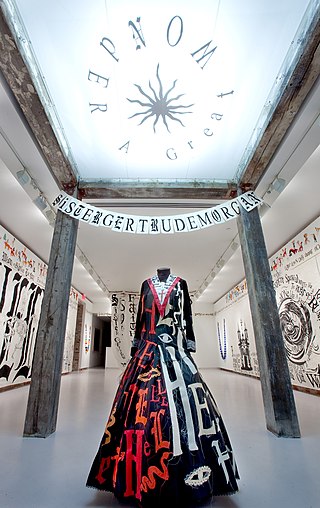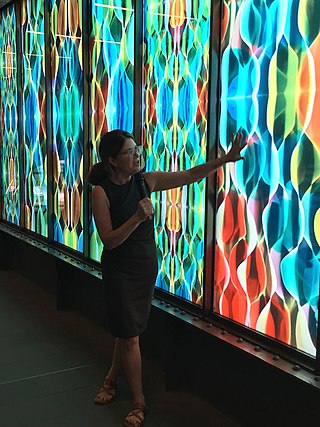
Diana Cooper is an American visual artist, known for largely abstract, improvised hybrid constructions that combine drawing, painting, sculpture, installation and photography. Her art has evolved from canvas works centered on proliferating doodles to sprawling installations of multiplying elements and architectonic structures. Critics have described her earlier work—primarily made with craft supplies such as markers, pens, foamcore, pushpins, felt, pipe cleaners, tape and pompoms—as humble-looking yet labor-intensive, provisional and precarious, and "a high-wire act attempting to balance order and pandemonium." They note parallels to earlier abstract women artists such as Eva Hesse, Lee Bontecou, Elizabeth Murray, and Yayoi Kusama. Lilly Wei, however, identifies an "absurdist playfulness and Orwellian intimations" in Cooper's work that occupy a unique place in contemporary abstraction.

Hannah Wilke (born Arlene Hannah Butter; was an American painter, sculptor, photographer, video artist and performance artist. Her work is known for exploring issues of feminism, sexuality and femininity.

Lesley Dill is an American contemporary artist. Her work, using a wide variety of media including sculpture, print, performance art, music, and others, explores the power of language and the mystical nature of the psyche. Dill currently lives and works in Brooklyn, New York.
Jane R. Hammond is an American artist who lives and works in New York City. She was influenced by the late composer John Cage. She collaborated with the poet John Ashbery, making 62 paintings based on titles suggested by Ashbery; she also collaborated with the poet Raphael Rubinstein.

Lynda Benglis is an American sculptor and visual artist known especially for her wax paintings and poured latex sculptures. She maintains residences in New York City, Santa Fe, New Mexico, Kastellorizo, Greece, and Ahmedabad, India.
Judy Pfaff is an American artist known mainly for installation art and sculptures, though she also produces paintings and prints. Pfaff has received numerous awards for her work, including a John D. and Catherine T. MacArthur Foundation Fellowship in 2004 and grants from the John Simon Guggenheim Memorial Foundation (1983) and the National Endowment for the Arts. Major exhibitions of her work have been held at the University of Wisconsin–Madison, the Denver Art Museum and Saint Louis Art Museum. In 2013 she was elected to the American Academy of Arts and Sciences. Video interviews can be found on Art 21, Miles McEnery Gallery, MoMa, Mount Holyoke College Art Museum and other sources.

Alyson Shotz is an American sculptor based in Brooklyn, New York. She is known for experiential, large-scale abstract sculptures and installations inspired by nature and scientific concepts, which manipulate light, shadow, space and gravity in order to investigate and complicate perception. Writers suggest her work challenges tenets of monumental, minimalist sculpture—traditionally welded, solid, heavy and static—through its accumulation of common materials in constructions that are often flexible, translucent, reflective, seemingly weightless, and responsive to changing conditions and basic forces. Sculpture critic Lilly Wei wrote, "In Shotz’s realizations, the definition of sculpture becomes increasingly expansive—each project, often in series, testing another proposition, another possibility, another permutation, while ignoring conventional boundaries."

Annabeth Rosen is an American sculptor best known for abstract ceramic works, as well as drawings. She is considered part of a second generation of Bay Area ceramic artists after the California Clay Movement, who have challenged ceramic traditions involving expression, form and function and helped spur the medium's acceptance in mainstream contemporary sculpture. Rosen's sculptures range from monumental to tabletop-sized, and emerge out of an accumulative bricolage process combining dozens or hundreds of fabricated parts and clay fragments and discards. Reviewers characterize her art as deliberately raw, both muscular and unapologetic feminine, and highly abstract yet widely referential in its suggestions of humanoid, botanical, aquatic, artificial, even science-fictional qualities. Critic Kay Whitney wrote that her work is "visceral in its impact, violent even, but also sensual and evocative" and "floats between the poles of the comic and the mordant."

Bobbi Mastrangelo (1937-) is an artist specializing in relief sculpture, mixed media, and fiber art including handmade cast paper. She was born Barbara Ann Betschen on May 16, 1937 in Youngstown, Ohio. Her work is best known for its unusual focus on the theme of manhole covers and water covers, grates and drains. Her art has been exhibited widely throughout the United States and is in the collections in several museums.

Nene Humphrey is a New York-based multidisciplinary artist. Her work has been compared to that of Kiki Smith, Janine Antoni, Petah Coyne, and Louise Bourgeois. She has lived and worked in New York since 1978. Humphrey’s work explores the body, loss, the neuroscience of emotion, and the beauty inherent in both. The integration of art and science is fundamental to Humphrey’s art practice, which often takes the form of iterative research-based projects.
Mimi Smith is an American visual artist. She is a pioneer in early feminist and conceptual art focusing on clothing sculpture and drawing installation. She lives and works in New York City.

Nade Haley was an American visual artist whose work has been exhibited at numerous museums and galleries, and is held in public and private collections. After relocating from Washington DC, Haley lived and kept studios in New York City and in Cape Breton, Nova Scotia.
Robin Hill is an American visual artist whose work focuses on the intersection between drawing, photography, and sculpture. Since 2001, she has been on the faculty of the Art Studio Program in the Department of Art and Art History at the University of California, Davis.

Lisa Hoke is an American visual artist based in New York City and Hudson Valley, New York. She is known for colorful, immersive installations and abstract sculptures characterized by labor-intensive working processes and inventive use of repurposed consumer detritus as raw materials. Her work has often challenged notions of mastery, permanence and fixed meaning, embracing qualities such as contingency and transience. In early sculptures, she tested gravity and balance with intuitively arranged, tenuous suspensions; her later large-scale installations are created on-site and dismantled after exhibition, their materials saved for future re-use. Hoke first gained recognition in the 1990s as one of a number of sculptors that mined the domestic sphere for materials and ideas, in her case, mixing elements of formalism and postminimalism, Pop assemblage, and social, often feminist, commentary. In the 2000s, critics have compared the bright, swirling forms and textures of her installations to the varied surfaces of Antoni Gaudí and the sparkling patterns of Seurat and Klimt.
Cyrilla Mozenter is a New York-based artist known for her hand stitched industrial wool felt freestanding and wall pieces that include the transplantation of cutout letters, letter-derived, and pictogram-like shapes, as well as her hybrid works on paper, incorporating drawing, writing, painting, and collage. Her works make reference to the writings of Gertrude Stein. Awarded a Guggenheim Fellowship in 2020, her work is represented in many public collections including The Brooklyn Museum and The Yale University Art Gallery.

Maureen McQuillan is a New York-based contemporary artist, who, though primarily a painter, has worked in a range of mediums that include drawing, painting, camera-less photography, and sculptural installation. Across disciplines, she uses color and flowing line to create her complexly patterned abstractions.

Elana Herzog is an American installation artist and sculptor based in New York City. She is most known for abstract, tactile works in which she disassembles, reconfigures and embeds second-hand textiles in walls, modular panels and architectural spaces with industrial-grade metal staples. Herzog has been recognized with a Guggenheim Fellowship, Anonymous Was a Woman Award and Louis Comfort Tiffany Foundation Award, among others. She has exhibited nationally and internationally, including at the Brooklyn Museum, Museum of Arts and Design (MAD), Tang Museum, Weatherspoon Art Museum, Sharjah Art Museum, and Reykjavik Art Museum.

Heide Fasnacht is a New York City-based artist who works in sculpture, drawing, painting and installation art. Her work explores states of flux, instability and transformation caused by human action and natural events. Since the mid-1990s, she has been known for sculptures and drawings that recreate momentary phenomena such as sneezes, geysers and demolitions—in sometimes abstract or cartoony form—that are temporally and spatially "frozen" for consideration of their aesthetic, perceptual, social or sensate qualities. In the late 2010s, she has expanded these themes in paintings that examine lost and neglected childhood sites, such as playgrounds and amusement parks. ARTnews critic Ken Shulman has described her work as "chart[ing] the fluid dialogue between second and third dimensions, motion and inertia, creation and ruin."

Elise Siegel is an American sculptor and installation artist based in New York City. She is known for several bodies of figurative work that use subtle and ambiguous gesture and facial expression to evoke psychic and emotional states. In the 1990s, she first gained recognition for garment-like constructions that blurred boundaries between clothing, skin and body, critiquing the roles fashion and plastic surgery play in the construction of sexual and cultural identity; writer Mira Schor included Siegel among the cohort of artists she dubbed "Generation 2.5" and credited for developing the tropes of feminist art. After shifting to clay as her primary material, Siegel was one of a number of artists in the 2000s whose work spurred a rebirth in figurative ceramics emphasizing emotional expression, social conditions, identity and narrative. Her ceramic work—which ranges from roughly modeled portrait busts to highly charged, theatrical installations—is said to capture fleeting moments of internal struggle, conflict and vulnerability, creating a psychological tension with the viewer.

Nancy Bowen is an American visual artist. She is known for two main groups of work that share qualities of hybridity and multiplicity in their materials and inspirations: largely abstract sculptures and collaged works on paper. Writers such as curator Nina Felshin situate her sculpture amid a strain of feminist art based in the physical body, which emerged in the 1980s to reclaim female imagery from male-dominated conceptions of women often theorized under the concept of the "male gaze." According to Felshin, in Bowen's work this involves an "exploration of the fragmented, internal body as a means of communicating the visceral experience of [embodiment] … By fashioning anatomically evocative objects from tactile, sensuous and sometimes decorative 'craft' materials … [she] emphasizes the body as a sensory instrument." Bowen's later collages connect her New England roots and Eastern spiritualism through the language of contemporary art.

















